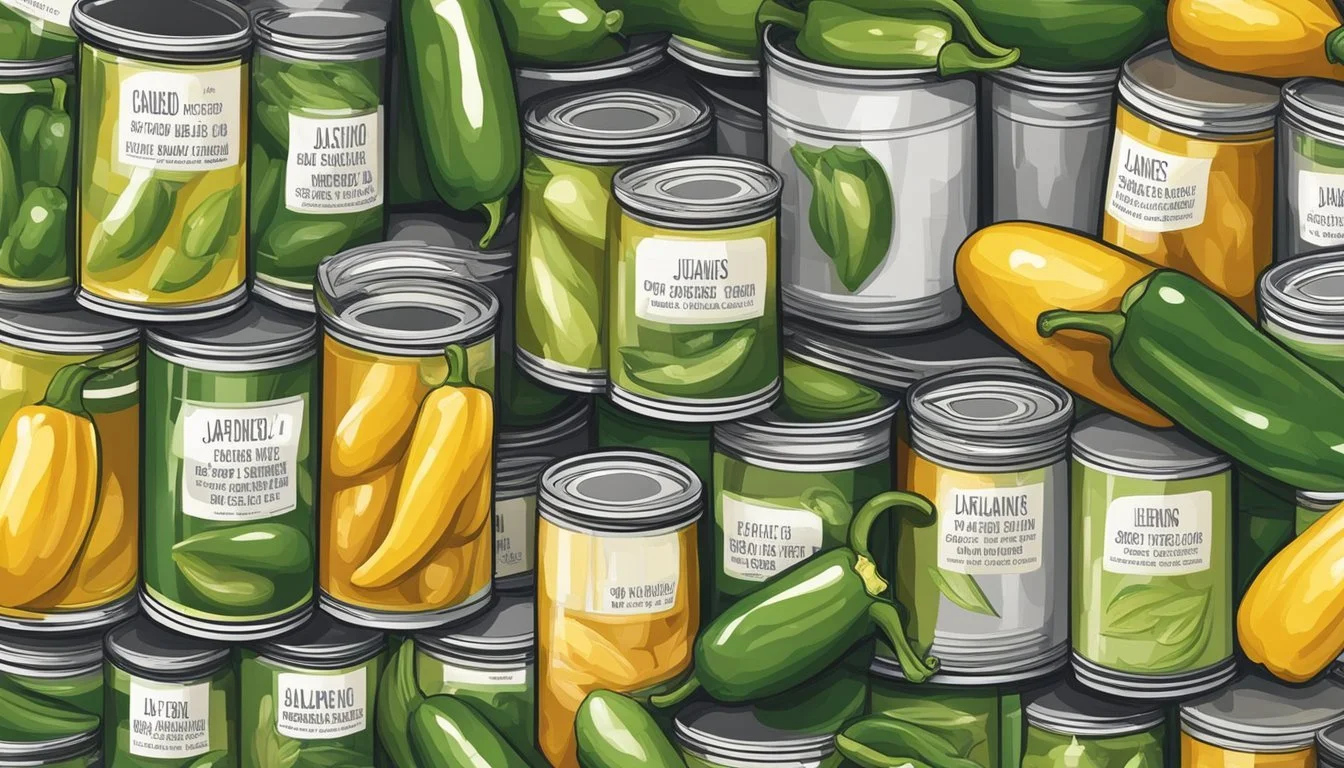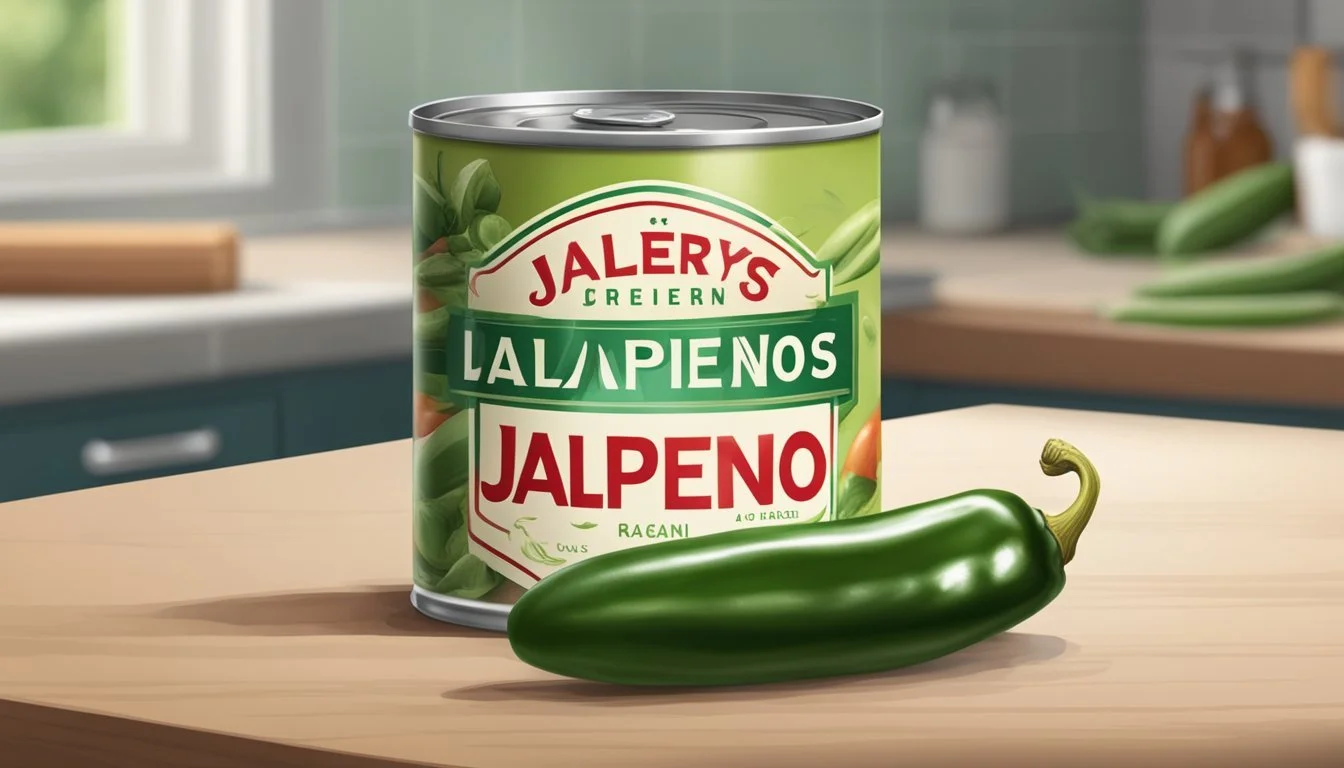Do Canned Jalapeños Go Bad?
Storage Tips and Shelf Life
Canned jalapeños are a versatile and spicy addition to many dishes, but how long can you keep them before they go bad? Canned jalapeños, when unopened, can last for 2 to 5 years if stored properly, remaining safe and of good quality beyond the expiration date if the can remains undamaged. Once opened, their shelf life decreases significantly, typically lasting only 2-3 weeks in the refrigerator.
Proper storage conditions are crucial to prolonging the freshness of canned jalapeños. Keeping them at a consistent, cool temperature and ensuring the can is sealed and undamaged help maintain their quality and safety. Exposure to extreme temperatures or humidity can adversely affect their viability.
When assessing whether opened canned jalapeños have gone bad, look for signs of mold, a sour smell, or a change in appearance. If any of these indicators are present, it’s best to discard them to avoid any health risks. Eating moldy or rotten jalapeños is not worth the risk, so always ensure they are stored correctly and checked for freshness.
Understanding Canned Jalapeños
Canned jalapeños undergo a detailed process to ensure preservation and flavor retention. These peppers come in various forms, including whole, sliced, and pickled, giving consumers multiple options to suit their culinary needs.
Canning Process
The canning process for jalapeño peppers typically involves several key steps: selection, cleaning, cutting, filling, and sealing. Fresh jalapeños are picked and cleaned thoroughly to remove dirt and bacteria.
Following cleaning, the peppers might be sliced, depending on the product. The jalapeños are then packed into cans with a brine solution consisting of water, vinegar, and salt. This brine helps preserve the peppers and contributes to their flavor.
The cans are sealed and heat-processed to kill any remaining bacteria, ensuring the product's safety and longevity. This method allows canned jalapeños to maintain their spiciness and texture for extended periods, making them a convenient pantry staple.
Types of Canned Jalapeños
Canned jalapeños are available in various forms, each offering distinct uses and flavors. Whole jalapeños are often used in recipes where the pepper is presented as a focal ingredient. Sliced jalapeños are convenient for garnishing and adding to dishes like nachos, pizzas, and sandwiches.
Pickled jalapeños are immersed in a tangy brine, enhancing their flavor with a balance of sour and spicy notes. They can be found in jars or cans and are great for adding to salads, burgers, and tacos. Each type retains the characteristic heat of jalapeños, measured on the Scoville scale, thanks to capsaicin, the compound responsible for their spiciness.
Proper Storage Practices
Storing canned jalapeños correctly ensures their freshness and safety. This applies both before and after the can is opened.
Before Opening
Unopened canned jalapeños should be stored in a cool, dry area. A pantry or cupboard is ideal for maintaining optimal storage conditions. The temperature should be kept consistent and cool to preserve the quality of the jalapeños.
Store cans away from direct sunlight and heat sources, as these can accelerate spoilage. The storage space needs to be dry to prevent rusting or damage to the can.
Properly stored, unopened cans remain at their best quality for 3 to 5 years. While they may be safe to consume after this period if the can is undamaged, it's always best to check for signs of deterioration.
After Opening
Once opened, canned jalapeños should be transferred to an airtight container. This helps maintain their flavor and prevents contamination. The container should then be placed in the refrigerator, preferably in the vegetable drawer where the temperature is more stable.
Consume the opened jalapeños within 2-3 weeks for best quality, although factors like preservation methods may affect this timeframe. Regularly check the jalapeños for signs of mold or discoloration, as these are clear indications they should be discarded.
Always seal the container tightly after each use to prolong freshness. Avoid leaving the opened can in the fridge, as it may cause the jalapeños to spoil faster.
Identifying Spoilage
When determining if canned jalapeños have gone bad, it is important to examine their appearance, smell, taste, and the condition of the can itself. Each of these factors can offer clear signs of spoilage.
Visual and Textural Signs
Look closely at the jalapeños for any discoloration or the presence of mold. While jalapeños should retain their green color, signs of spoilage may include discolored spots or browning.
Check the texture as well. Fresh jalapeños should be firm, but once they go bad, they often become soft and may appear soggy. Brown seeds inside the peppers are also an indicator that they may be rotten.
Smell and Taste
Spoiled jalapeños often have an off odor that can be unpleasant and strong. If the jalapeños smell different than when they were freshly opened, it is a sign they might not be safe to consume.
Tasting is less desirable but can be done cautiously. A sour or off taste should alert you to discard the jalapeños. Always ensure to spit out any jalapeño that tastes unusual to avoid ingesting potentially harmful substances.
Can Integrity
Inspect the can itself for signs of damage. Any can that is bulging, dented, or leaking may contain spoiled contents. These forms of damage can disrupt the seal and allow bacteria to grow, which speeds up spoilage.
Check for rusting on the can. Rust can compromise the integrity of the can and contaminate the jalapeños inside. Discard any cans showing excessive rust or other signs of compromise.
Ensure the expiration date is also checked. While jalapeños can be safe past the best-by date, signs of spoilage should prompt immediate disposal.
Shelf Life and Expiration
Canned jalapeños can have a shelf life of 2 to 5 years if they remain unopened and are stored properly. Factors like storage conditions, manufacturing date, and packaging quality play crucial roles in determining their longevity.
Expiration dates on cans usually serve as guidelines for the best quality. Consumers often refer to these as "best by" dates. While it's best to consume them within this time frame, the peppers can remain safe past these dates if the can is undamaged.
After opening, the shelf life of canned jalapeños decreases significantly. Opened cans should be refrigerated and used within 2-3 weeks. Extending this time isn't recommended due to potential quality and safety concerns.
Here's a quick summary:
Condition Shelf Life Unopened, properly stored 2 to 5 years Opened, refrigerated 2 to 3 weeks
Always check for signs of spoilage such as unusual odors, changes in texture, or any visible mold before using expired canned jalapeños.
Safety and Health Considerations
It's essential to understand the safety measures and health implications of consuming canned jalapeños. Proper handling can prevent food poisoning, while moderation can help manage the spiciness and potential heartburn.
Preventing Food Poisoning
Canned jalapeños must be stored correctly to ensure they remain safe to eat. They can last up to 5 years if unopened and kept in a cool, dry place. An undamaged can is crucial for preventing harmful bacteria growth.
Once opened, store them in a sealed container in the refrigerator and consume within a few weeks. Signs of spoilage to watch for include a bulging can, unpleasant odor, and visible mold. Consuming jalapeños that have gone bad can result in food poisoning, which is why adhering to storage recommendations is vital.
Handling Heartburn and Spiciness
Jalapeños are known for their spicy heat, which can cause heartburn in some individuals. To reduce the likelihood of heartburn, consume small amounts and pair them with dairy products like yogurt or milk, which can neutralize the spiciness.
Use them sparingly in dishes to manage their intensity. For those sensitive to spicy foods, opting for mild varieties or removing the seeds can help. Staying hydrated with water or milk can also alleviate the burning sensation. Monitoring one's consumption and reactions is key to enjoying jalapeños without discomfort.
Alternatives to Canned Jalapeños
When canned jalapeños are not available or if you're looking for different ways to enjoy jalapeños, consider using fresh jalapeños or freezing them. These alternatives provide flexibility and can maintain the flavor and heat of the peppers for various culinary uses.
Fresh Jalapeños
Fresh jalapeños offer a crisp texture and bright flavor that many people find preferable to canned varieties. When storing fresh peppers, place them in a plastic bag with some air inside to avoid moisture accumulation. Proper storage in the refrigerator extends their freshness for up to two weeks.
Selecting firm, unblemished jalapeños ensures the best quality. They can be chopped and added to salsas, salads, or cooked meals for a spicy kick. It's important to note that the seeds and membranes contain most of the heat, so removing them can reduce the spiciness if desired.
Freezing Jalapeños
Freezing jalapeños is an excellent method to preserve excess peppers. Start by washing and drying the peppers thoroughly. Place whole or sliced jalapeños in a freezer bag, removing as much air as possible to prevent freezer burn and loss of flavor.
Frozen jalapeños can last up to six months while retaining their heat and flavor. Remember to label the bags with the date of freezing. These peppers can be used straight from the freezer in cooked dishes like soups, stews, and casseroles without the need for defrosting.
Usage in Cooking
Canned jalapeños offer versatility in the kitchen, making them a convenient option for adding a spicy kick to various recipes.
They can be used whole or sliced based on the dish's needs. Their flavor is distinctly tangy with a mild to medium heat that complements a wide range of ingredients.
In cooked dishes, canned jalapeños can be incorporated into soups, stews, and casseroles. They enhance the flavor profile and add a touch of heat without overwhelming the dish.
Tacos and nachos benefit greatly from the addition of these peppers. Their spiciness pairs perfectly with the savory flavors of meat, cheese, and beans.
When making dips or salsas, diced canned jalapeños add both flavor and heat. They can be blended smoothly into sauces or left chunky for texture.
The liquid from canned jalapeños should not be discarded. It can be used to marinate meats or added to salad dressings, providing an extra layer of tangy heat.
Consider adding them to pizzas, burgers, and sandwiches to give these items a vibrant punch. Their flavor complements a variety of cheeses, meats, and even vegetables.
In egg-based dishes like omelettes or quiches, they bring a pleasant spiciness that elevates the overall taste.
By experimenting with canned jalapeños in different culinary contexts, one can discover numerous delicious possibilities.
Frequently Encountered Problems
Canned jalapeños can present several issues that affect their usability and safety, particularly related to physical damage to cans and changes in quality over time.
Physical Damage to Cans
One common issue with canned jalapeños is physical damage to the packaging. Dented or bulging cans are primary concerns. A dented can could compromise the seal, potentially allowing bacteria to enter, which increases the risk of spoilage. Bulging cans indicate gas buildup, often a sign of bacterial contamination.
Consumers should avoid using damaged cans. Store cans in a stable, cool environment to reduce the risk of dents and keep an eye out for any signs of swelling or damage before use.
Changes in Quality Over Time
Over time, canned jalapeños may experience changes in quality, even if they are stored under optimal conditions. The texture can become less crisp and more mushy. This is due to prolonged exposure to the acidic brine in which they are packed.
Additionally, the color of jalapeños might become duller, and their flavor can lose its intensity. It's also possible for the peppers to appear wrinkled. Stored correctly, unopened cans can last for 2-5 years, but consuming them sooner rather than later is preferable for best quality.








